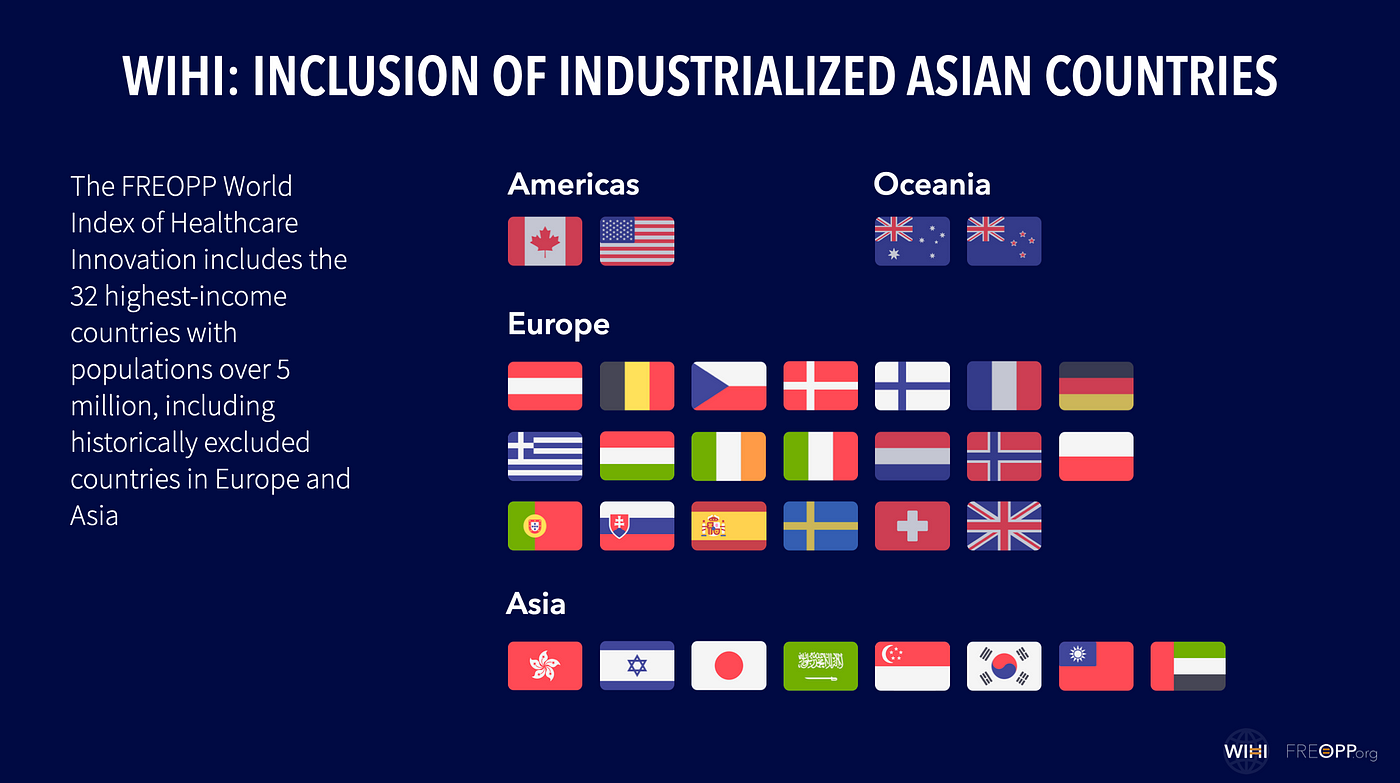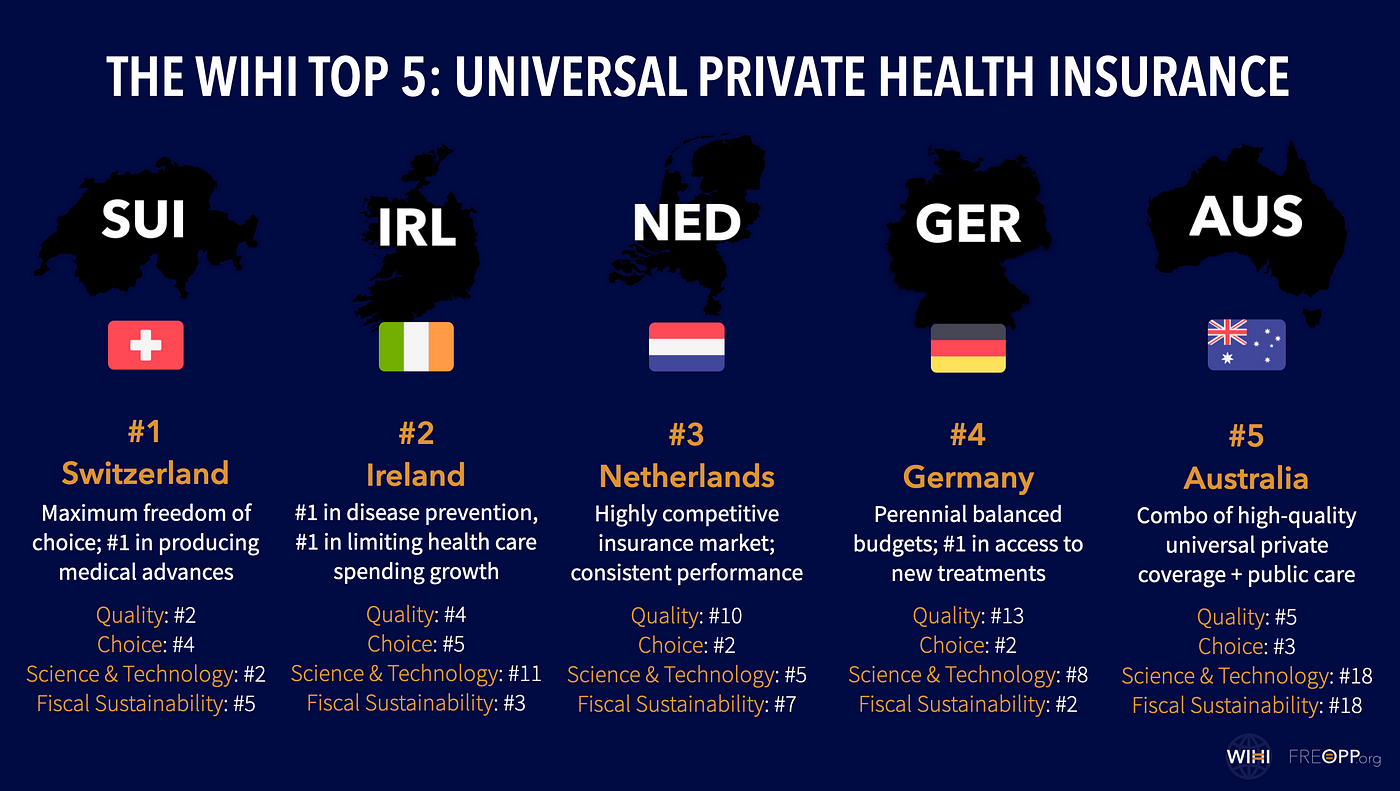Executive Summary
There was a fair amount of movement in FREOPP’s third annual World Index of Healthcare Innovation. But at the top, there was one constant: Switzerland, which ranked first in the 2022 rankings, as it did in 2021 and 2020.
Four countries earned an Elite overall rating: Switzerland (1st), Ireland (2nd), the Netherlands (3rd), and Germany (4th). Switzerland was consistently strong across the board.
While Switzerland’s performance has been consistent through the years, a number of other countries have moved significantly up and down the rankings since 2020. Notably, Nordic countries Denmark (+7), Sweden (+7), and Finland (+7) moved up substantially, as did Australia (+6). Denmark’s rise was driven by improved access to new treatments; Sweden’s by improvements on patient-centered care and performance during the pandemic; Australia’s by improvement in patient access to generic drugs.
The most significant declines in the rankings since 2020 belong to the United States (-7), the Czech Republic (-12), and Canada (-8). All three declines were in part the result of declines in Fiscal Sustainability.
The United States falls to 11th
The United States’ decline to 11th place was primarily fueled by a drop in Fiscal Sustainability (last in 2022 vs. 29th in 2021). The decrement was driven by a very high amount of government COVID relief spending, relative to other countries, and an adjustment to our methodology which takes into account the demographic ability of a country’s younger workers to fund the health care of the elderly.
The U.S. did improve its ranking in Choice (10th in 2022 vs. 20th in 2021) and maintained its wide lead atop the Science & Technology rankings.
About the Index
The World Index of Health Care Innovation (WIHI), begun in 2020, is the most comprehensive comparison available today of health care systems in high-income countries. WIHI examines health care systems across four dimensions: Quality, Choice, Science & Technology, and Fiscal Sustainability.
WIHI includes the 32 countries with the highest gross domestic product per capita on a purchasing-power basis with populations over 5 million. In 2022, for the first time, the Index included the Kingdom of Saudi Arabia, which met these criteria.
Notably, WIHI includes five high-income Asian countries that are not members of the Organisation for Economic Co-operation and Development (OECD): Hong Kong, Saudi Arabia, Singapore, Taiwan, and the United Arab Emirates. This is significant, because most other comparisons of health systems only examine OECD countries, and thereby exclude a number of nations with high-performing health care.

For more on the methodology used in the Index, click here. For more on what makes the Index different from previous comparison of national health care systems by other institutions, click here.
The success of universal private health insurance
Contrary to the perception of many in the U.S. that universal coverage can only be achieved through a “single-payer” system in which private health insurance is abolished and replaced by a government-run insurer, five of the top six countries in the 2022 Index have achieved universal coverage using private insurance: the aforementioned European four, along with Israel (6th). 5th-ranked Australia achieves universal coverage through the universal availability of both public and private insurance, much like how Americans have the freedom to choose public schools, or pay extra for private education.

Why do countries with universal private insurance do so well in the FREOPP survey? There are several reasons. Private insurance systems empower patient choice, and create room for insurers to organically evolve their benefit designs without having to wait for politicians or regulators to act. In addition, universal private systems tend to be more fiscally sustainable, because countries can means-test their subsidies and phase them out as one ascends the income scale.
(Notably, the United States, with its hybrid public-private system, does not meaningfully means-test its subsidies. Wealthy individuals over 65 get heavily subsidized coverage through Medicare, and high earners under 65 receive large subsidies through the tax code for employer-based coverage.)
The highest-ranking single-payer country was Denmark (7th).
The Index rated countries ranked 5th through 14th as having Good health care systems. Along with Australia, Israel, and Denmark, Sweden ranked 8th, followed by Belgium (9th) and Singapore (10th). The United States fell to 11th, followed by the Hong Kong special administrative region (12th), Taiwan (13th), Norway (14th), and the United Kingdom (15th).
Countries ranked 16th through 26th were rated Moderate, including Finland (16th), New Zealand (17th), South Korea (18th), the United Arab Emirates (19th), the Czech Republic (20th), Spain (21st), Portugal (22nd), Austria (23rd), France (24th), Canada (25th), and Japan (26th).
Countries rated Poor hailed mostly from southern and eastern Europe: Greece (27th), Slovakia (28th), Hungary (29th), Italy (30th), Saudi Arabia (31st), and Poland (32nd).
The impact of COVID-19 on our rankings
As detailed in our methodology paper, WIHI measures each country’s response to the COVID-19 pandemic, relative to other factors. The winner on this measure was once again the United Arab Emirates, a country that did a better job than most of avoiding COVID fatalities while also rapidly vaccinating its population.
The United States ranked 23rd in COVID-19 pandemic performance, owing to its relatively high mortality rate, its poor vaccination rate, and the stringency of its economic restrictions in major population centers in the Northeast and West Coast.
